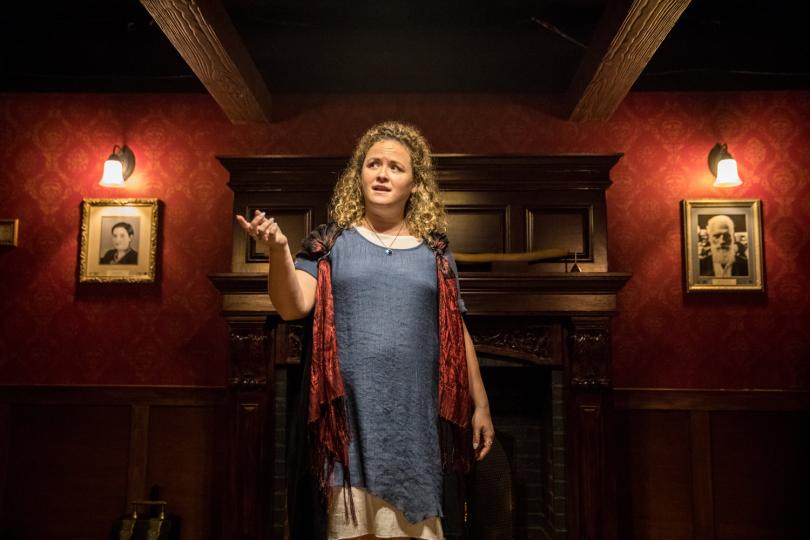Promenade Style Theatre Meets The Puzzle Room

The arts and entertainment world isn’t new to genre blending: from horror plus sci-fi movies like Event Horizon, to dance plus theatre works like Live Action Set--even Dungeons & Dragons started as blend of traditional war gaming mixed with the fantasy genre before becoming its own form of entertainment.
In Cabal, Walking Shadow Theatre Company brings together promenade style theatre and -- what is fast becoming a major entertainment choice in the Twin Cities -- the Puzzle Room.
A few disclaimers:
- The production I saw featured a good friend (and the chair of my theatre company Swandive Theatre): Jamie Case
- There will be little to no ‘details’ about this production as I don’t want to provide spoilers to what is deliberately a mysterious production
This isn’t WSTC’s first foray into this theatre/puzzle mix because in 2011 they produced Saboteur. While I didn’t see the production, my understanding was that the piece was more focused on the puzzles and less on the performance. With Cabal, WSTC has tried to truly merge and balance the two formats.
In 2016, David Pisa struck out on his own to do puzzle room creation and consultation, so it was only a matter of time before WSTC grappled with this format again. Overall Cabal is a success: it merges the two formats (participatory theater and puzzle room) into a 90 minute unique and, mostly, fulfilling experience. I strongly recommend you check it out. Because this can’t be a traditional review I’ve opted to ditch the standard format and provide a generic breakdown of what works and what doesn’t hopefully without giving anything away.
What doesn’t work
TRANSITIONS
The show is structured in such a way that your group watches two actors performing and moving a story along. At certain points, your group is asked to participate in a puzzle of some kind (which contributes to the story) or one of the character’s understanding of events. After the puzzle concludes,then the story picks back up. I found many of these transitions clunky, particularly when going from a puzzle back into the story. The clunkiness was not in the execution, but instead there seemed to be no way to make a smooth blending of genres. It was more like a light switch. Our group would be in the “solve the puzzle” head space and then, once the puzzle was solved, it was *click* time to “watch the play.”
Which leads to...
THE PLAY MECHANICS
The story of Cabal is nerdy and fun (more below on that in the ‘what works’ section). Early on a convention is established that you (and your group) are part of this story. The difficulty though is from there on out your only contribution is solving puzzles. The story itself is on a railroad track that fights the engagement sensation driven by the puzzles. The story happens in a vacuum and we just watch, while the solving of puzzles technically advances the story, the relationship between the two mostly feels tangential. This puts the onus on the actors to continually manage the stakes of the story. That becomes challenging, however, when a puzzle starts--no matter which performer we were engaging with, they would faded into the background. They were relegated to only chiming in when we were stuck, or giving us a “those aren’t to be touched” warning, which robbed them of their potency as characters.
All of this made for an artificiality that prevented me from being more engaged, and created a disconnect because I couldn’t participate or intervene in the story.
YOUR GROUP
The maximum group allowed in a Cabal performance is 10. And it is at least four (and maybe even six) too many. Our group had 10 people and it meant for that during some of the puzzles there were a few folks just standing around and looking at what was happening. The first puzzle “room” I ever played was the now defunct House on Lydale from Trapped. What made it possible to have 10 (or even 16, which I think was the max allowed) was that there were three or four puzzles being solved simultaneously over multiple rooms. So your group would naturally split off into sub-groups to accomplish these, and those puzzles ultimately worked together to provide clues to a master puzzle that moved you further through the house. This just wasn’t possible with Cabal’s structure. If you can get a show with only 4-6 people attending I think the experience will be overall more pleasurable.
Because of the booking process (and this is true for many puzzle rooms) you may be participating with random strangers. Cabal does a nice job of setting up an environment to connect but ultimately you are about to participate in an experience with some people you don’t know. We happened to have four people (a couple and two solo folks) with my group of six for our show, and one of the individuals wasn’t the most considerate participant. That affected my ability to suspend my disbelief and really dive in. At $45 a ticket for a 90-minute experience, I wish it was possible to book a show with your own group and lock it down so you know who you are playing with. I understand that it isn’t financially feasible, but I feel bad for anyone that has attended and paid full price to have their experience marred by another participant.
What works
THE DESIGN
Oh Em Gee! This is an absolutely stunning, beautiful, surprising, and inspired design. Each room in the show is gorgeous and used to great effect. The level of detail and care put into all the little things truly shows. I had a personal favorite space which I won’t share, but suffice it to say that as a theatre producer who worked on this set (An Outopia for Pigeons), the room took my breath away and gave me all the warm fuzzies. As a visual masterpiece in scenic craft Cabal is worth the price of admission. Hat’s off to David Pisa and his team for the design.
THE SCRIPT
John Heimbuch’s script felt like it was pulled from my college years playing White Wolf’s Mage the Ascension role playing game. That’s as much as I can give you without spoilers. It contains a deep level of nerdiness, fun, twists, turns, myth, and mythos. If you lean into what he is putting into the room you can get swept up in it. Despite the challenges of genre blend and transitions, the script is a ton of fun and keeps the stakes high so that you really WANT to find out what happens next. The climax of the production manages to be both introspective and fulfilling. Kudos to John, the performers, and the playtesters for this undertaking.
THE PERFORMERS
Tara Borman (as Morgan Zakar) and Jamie Case (as Jack Nimble) do a bang up job. Their role as part performer, part guide, part referee, and part participan is no easy feat. They both manage to traverse the challenges I described above with fluidity and grace. They have a great chemistry together and it shows in the climactic moments of the experience. As I understand it, the role of Jack Nimble will be played by another performer for the foreseeable future of the run, but Jamie Case will still be performing on select shows.
An Addendum to what didn’t work
So here’s the rub. There may be no way to solve the first two issues. This may be part of the nature of mashing these two genres together. The third issue (group) is likely a matter of financial necessity and considering what WSTC has undertaking with Cabal it is a small quibble on my part.
As I walked away from the show and chatted with the group I attended with, we recognized a big challenge with this production. Cabal is attempting to be a theatre show that can be enjoyed by the puzzle room crowd, a puzzle room that can be enjoyed by the theatre crowd, AND an entertainment choice for people who may rarely participate in either of those recreations. It is a tall order and on so many levels it hits the mark. But, I think ultimately each of those parts (puzzle / play) ends up getting a bit watered down in order to make the blend work.
Cabal is an undertaking of monumental proportions. It is worth the experience for so many reasons. The greatest of which, I believe, is that we are on the cusp of much more of this kind of genre-blending-entertainment. I hope that WSTC’s pioneering endeavor encourages other companies to experiment in this way. More can be done in this arena and Cabal is a nascent predecessor to what I imagine being even more exciting endeavors. What I do know is that the next time WSTC attempts to push the envelope, I’ll be at the front of the line.




